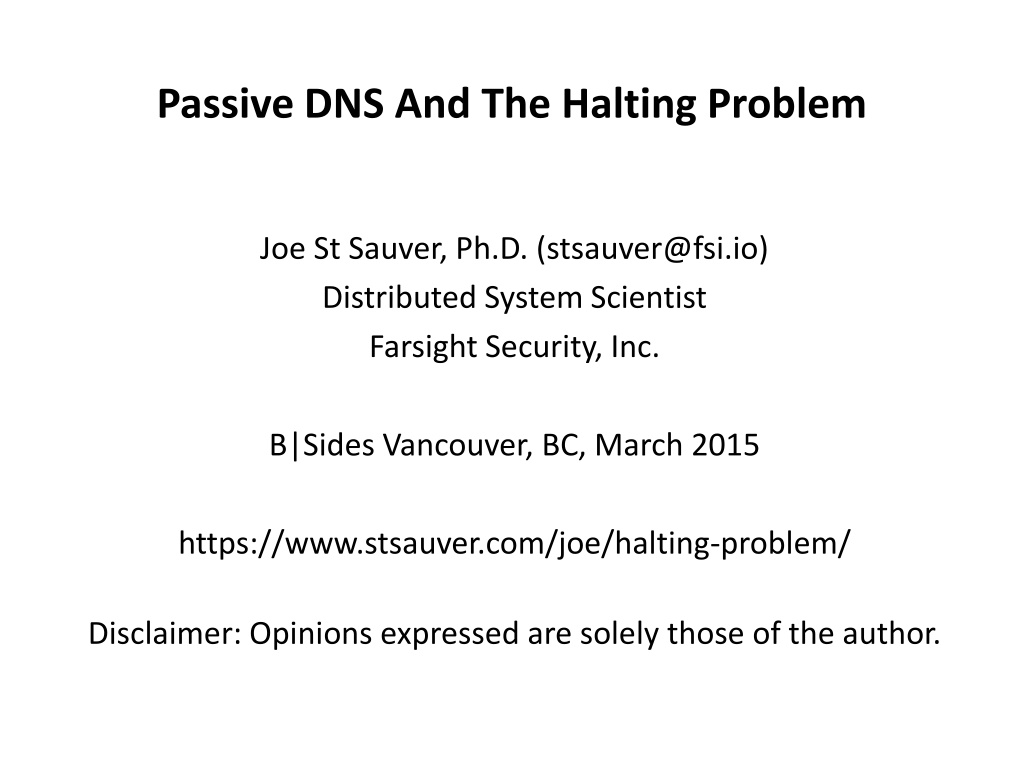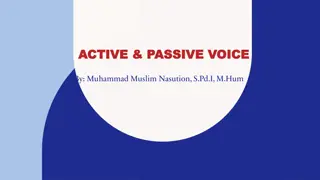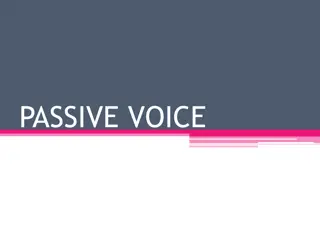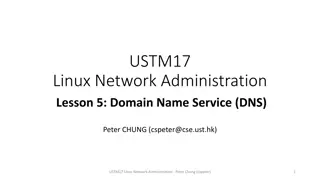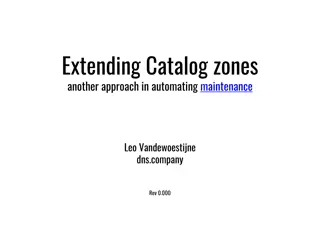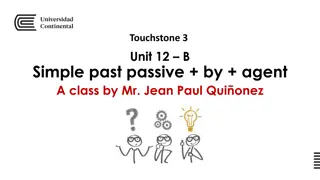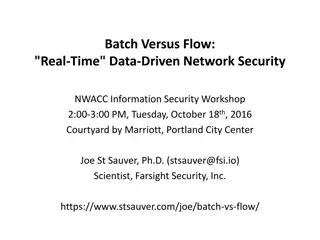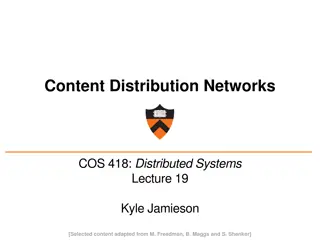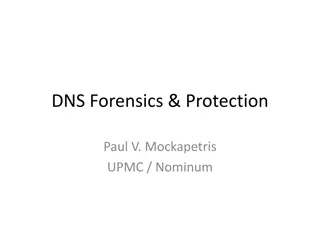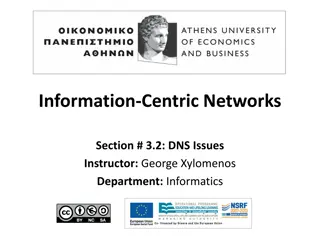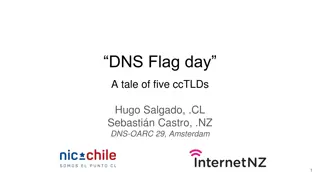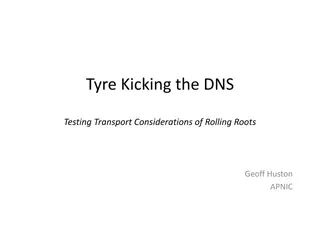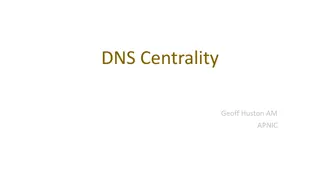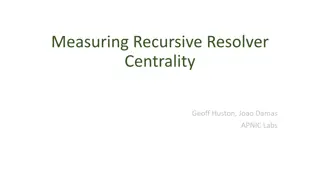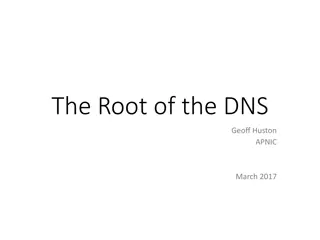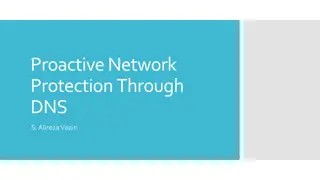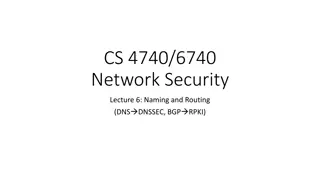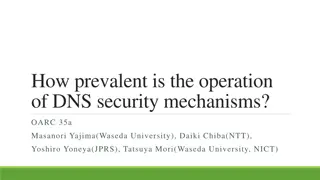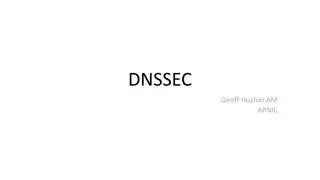Passive DNS And The Halting Problem by Joe St. Sauver, Ph.D.
Exploring the interplay between Passive DNS and the Halting Problem, this document presents insights shared by Dr. Joe St. Sauver at B|Sides Vancouver, BC in March 2015. The detailed presentation covers various aspects such as the dynamic format of the session, unique slide style, author's background, and the discussion on spam and Canada's Anti-Spam Legislation (CASL).
Download Presentation

Please find below an Image/Link to download the presentation.
The content on the website is provided AS IS for your information and personal use only. It may not be sold, licensed, or shared on other websites without obtaining consent from the author. Download presentation by click this link. If you encounter any issues during the download, it is possible that the publisher has removed the file from their server.
E N D
Presentation Transcript
Passive DNS And The Halting Problem Joe St Sauver, Ph.D. (stsauver@fsi.io) Distributed System Scientist Farsight Security, Inc. B|Sides Vancouver, BC, March 2015 https://www.stsauver.com/joe/halting-problem/ Disclaimer: Opinions expressed are solely those of the author.
Our Format Today I'm glad we're in Room II, because it means that we can have a more interactive format than would be possible in the larger room here at the Imperial. I've put together some material I'm planning to go over, but I encourage you to ask questions as we go along, should questions arise I've explicitly left some time to do so. If you don't like asking questions in front of the whole group, I'm also happy to chat after the session, or to visit by email These slides will be available on the B|Sides Vancouver web site, and from my web site, https://www.stsauver.com/joe/ 3
My Odd Slide Style Speaking of slides... Let me get it "out of the way" up front: I produce detailed slides. This style drives some people crazy, so I like to explain why I do things this way. I've tried the more-typical 3-4 bullets/slide (with ~15 slides for an hour long talk), but I find myself getting sidetracked, rambling/running over, or I end up missing/skipping stuff. I also deal with complex issues, and I HATE to be misquoted. My slide style prevents a lot of those problems, and means that you don't need to try to take notes. That said, I'm not going to read my slides word-for-word for you. You don't need to try to do so, either, although they are a sort of "closed captioning" if you're deaf or hard-of-hearing. I also write detailed slides to help people looking at them after the fact, and for indexing by web search engines. 4
My Background My Ph.D. is in Production and Operations Management Spent ~28 yrs at the Univ of Oregon Computing Center in Eugene Worked under contract for Internet2 (the U.S. counterpart to Canarie.CA) as their Nationwide Security Programs Manager under contract through UO, including running the highly successful InCommon SSL/TLS Certificate Program and the InCommon Multifactor Program I left UO in 4Q14 to go to work for Internet Hall of Fame award recipient Paul Vixie and his new company, Farsight Security, Inc. I remain active in a variety of industry-related roles including: Senior Technical Advisor, M3AAWG (I also lead the Identity Management SIG, and am particularly active in the anti-Pervasive Monitoring SIG) I remain on the Technical Advisory Group of the REN-ISAC I'm a Strategic Advisor, Online Trust Alliance (OTA) Board Member, Coalition Against Unsolicited Commercial Email (CAUCE) Community Representative, Broadband Internet Technical Advisory Group 5
Spam and Canada's Anti-Spam Legislation (CASL) Let me take a moment to congratulate all Canadians on passing an excellent anti-spam law. It was a happy day when CASL came into effect on January 15th! If you've not had a chance to review it yet, you should! Look at http://www.fightspam.gc.ca/ I'm particularly impressed to see the CRTC off to a fast start with a $1.1 million dollar penalty imposed just this March 5th. Nice work CRTC peopl! I'm hoping that all Canadians enjoy improved protection from unwanted email now, and well into the future. Seeing the terrific strides that Canada has taken also made me want to talk about using passive DNS to research cyber abuse "at scale," particularly when it comes to unsolicited email. I also wanted to talk about how to figure out when it's time to stop. 7
The Halting Problem You might not expect it to be hard to figure out when to quit: common sense says do the job, and when you're done, that's it. Sometimes that's exactly right. There are some problems that have a finite series of steps, and once you've completed those steps, there's an answer, and you're done. ("Count the number of candies in this bag.") Other problems are special because you may never know if you're "done," or if you've found the "best" answer, or if you've found the "complete" answer. Consider the graph on the next slide. 8
Numerically find max f(x) for x in (-, +) If we (naively) start at x=0, and then use the simple (bad) heuristic "go either - left or + right, as may most increase f(x), until f(x) begins to decrease," we'll eventually end up at the top of the right hand hill at x=~1.75, y=~5.1. That's a local maxima. But what about x=~-2.5, y=~6, on the left? It's obviously higher. And what about values you don't see, "off screen?" How do we know that there isn't a better solution out there "somewhere?" 9
You Could Try Random Starting Points, Different 's We can try to avoid hitting a local maxima by picking random starting points (rather than just starting at x=0), or by picking different 's, but we're still just numerically "rolling the dice" when it comes to finding a global (rather than local) maxima. You might now say, "Joe! How does this obscure mathematical thing apply to cyber security?" The answer is that when you're chasing clues in network forensics, you face a similar problem: how do you know you've found "everything" that's relevant? How do you know you're "DONE?" ACTIONS TARGETING VARIOUS UNWANTED ONLINE BEHAVIORS ARE OFTEN NOT DONE AT SCALE, AND IN FACT ARE ALL-TOO-OFTEN GROSSLY INCOMPLETE. 10
If Only Cyber Criminals Would Politely and Cooperatively Create Simple Infrastructures! Imagine a bad guy/bad gal using: -- Just one domain name (with accurate and un-privacy/proxy protected domain whois information) -- No IP agility, just one never-changing static IP address -- Name servers in the same domain and on the same IP -- Static, publicly accessible evil content, conveniently indexed by major search engines Straightfoward to investigate, take down, or prosecute. But of course, that's NOT what cyber criminals do. They want to avoid detection and takedowns/prosecutions, so they like to employ more complicated architectures, instead. 11
"Utopia" for the Bad Folks A portfolio of many seemingly normal/routine domain names to use at the same time, or Constantly changing domain names (in some cases used for just minutes before being dumped and replaced). One IP address now, different IP addresses later, or Many IP's in use at the same time (sometimes even fast fluxing). Name servers that may also be fast flux, or Shared name servers that are shared across tens of thousands of other domains, a few bad, but many good) Domain whois data that is privacy protected, and IP whois data that doesn't show any reassignments (no SWIPs/rwhois) Content display that varies according to visiting IP, the referrer string, the number of previous visits, etc. 12
What About the Good Folk? Routine "Stretch" Goals Find "ALL" closely-related evil IPs This helps identify compromised machines that may need remediation, It avoids leaving the miscreant with a base from which to recover You maximize chance of successfully chasing financial payment details and other business records for things like command and control servers You may even discover additional unknown criminal lines of business Find "ALL" closely-related evil domains Cyber criminals are using more and more domain names, so no choice More domains seized = more "news worthy" action, and more incentive to spend limited cycles on this case, not other alternative ones If you're an LEO, you wouldn't want to end up with an incomplete takedown/seizure (you know, potentially spawning online remarks such as "Hah hah hah, they seized a dozen of my domains, but they missed two hundred others, so I didn't even really notice it") 13
Domain Takedowns/Seizures It's not my plan to get into a discussion or whether domain takedowns/seizures are a "good" or "bad" tool for use by civil and/or criminal authorities. I've seen them used very carefully and professionally and effectively in ways that minimize or eliminate collateral damage, and I've seen them used in ways that seem to an outsider both ineffective and reckless. Today, however, I'm simply going to note that most takedowns are not exhaustive, and many cannot be exhaustive (a miscreant can always register another domain) Consider the March 2012 seizure of bodog.com, still returning a "seized domain" parking page today. However, bodog's brand remains up and operational in other TLDs, right? 14
Another Take Down Focus Area: Counterfeit Goods An easy-to-see example of the growth in the volume of domains seized/year can be seen in actions related to counterfeit goods: 82 domains seized Nov 2010 http://www.ice.gov/doclib/news/releases/2010/domain_names.pdf 132 domains seized Nov 2011 http://www.ice.gov/news/releases/ice-european-law-enforcement- agencies-and-europol-seize-132-domain-names-selling 307 domains seized Feb 2012 http://www.wired.com/2012/02/sports-domains-seized/ 690 domains seized Dec 2013 https://www.europol.europa.eu/content/690-internet-domain-names- seized-because-fraudulent-practices Nearly 5,000 domains allegedly seized under seal in October 2014 http://www.internetcommerce.org/undue-process/ But even with that rough doubling year over year, the authorities really still aren't executing domain seizures "at industrial scale" 15
Example Of What I Mean By "At Scale:" Conficker If you really want to see what I think of when I think of DNS takedown operations "at scale," consider something more like the 2nd major version of Conficker. As Farsight CEO Paul Vixie noted in his US Senate Judiciary Committee testimony from last summer: Conficker s second major version generated 50,000 (fifty thousand) domain names per day that had to be laboriously blocked or registered in order to keep the control of this botnet out of the hands of its criminal authors. Complicating the situation, these 50,000 domain names were split up across 110 different country code top-level domains that are each the property of a sovereign nation. The registries for these domains are a mix of private and public institutions, some with national government oversight and many without. Almost all of the 110 registries agreed to cooperate [...] http://www.judiciary.senate.gov/imo/media/doc/07-15-14VixieTestimony.pdf 16
It's Rare to See Examples of Action "At Scale" Some miscreants have evolved a survival strategy that emphasizes staying "too small to bother taking down" Other miscreants have learned that they can ALSO avoid takedowns simply by out scaling investigators They can create a new domain for a few bucks in mere seconds The authorities have to devote days or hours (and substantial expense) to trying to knock those domains down This was true for SOPA/PIPA (see https://www.stsauver.com/joe/managers-amendment/sopa- amended-version.pdf , when prompted "final" without the quotes), and it's true for most other take-down-oriented approaches today, except for voluntary use of blocklists (but Uncle Sam and Johnny Canuck don't publish blocklists!) 17
Only a Few Cyber Crime Areas Are Universally Hated Large-scale malware (like Conficker) is one such area. It's hated because it is so disruptive, and because large scale DDoS attacks rely on botted hosts. Providers get that, and that's why they voluntarily collaborate to deal with this threat. Child abuse materials are another obvious example of online conduct that everyone agrees is totally unacceptable. Law enforcement officers are willing to work long hours, and across borders, to stamp it out. Phishing is a third widely-regard-as-unacceptable online activity. But email spam? Web spam? Sadly, all too many are still unwilling to make the effort to mitigate it. It has been more or less a "safe crime" for many miscreants, at least pre-CASL. I'm hoping to see Canada lead the charge against unsolicited email, at scale 18
Enabling Action Against Unsolicited Email At Scale We need to help investigators understand how to use tools that WILL work at scale. More investigators need to learn how to start with one "thread" or "clue," using those starting points to uncover connections that can then lead to other threads that can also be successfully chased down The best tool I can think of for doing this is passive DNS. 19
A Few Limitations of Regular DNS Normal DNS is all about what's defined NOW, not what was true last week or last month when an incident may have happened Caching can complicate interpretation No way to "time shift" just to a period of interest No historical record of what's happened earlier Regular DNS assumes authoritative DNS has been properly configured to return consistent (and non-deceptive) answers Content distribution networks may tailor results by query location To be able to get in-addr queries, PTR records must have been created Need to hope that name servers haven't been directed to selectively respond with bad data (e.g., via use of RPZ) for some query sources Regular DNS works best for simple architectures. Even basic igh density virtual hosting environments can be tricky: with perhaps five hundred domains hosted on one IP which (if any) of those 500 domains should be returned as a PTR? 21
Some Infeasible Regular DNS Queries Show me all FQDNs under example.com (e.g., *.example.com) List all the domains that use the name server ns1.example.com Given the IP used by one FQDN, what other domain names are on that same IP address? Given a domain name, does it resolve to multiple (different) IPs? Has it moved around over time? If so, to what IP addresses? Show me all the SMTP TLSA domains (e.g., all domains matching _25._tcp.\* ) Which new gTLDs appear to be most popular? What domains have been used in the last five minutes? These queries are examples of the sort of things that "regular DNS" was just NOT designed to address... 22
Passive DNS Collection Passive DNS data is collected by passively monitoring DNS cache miss traffic above recursive resolvers, and then saving and indexing that data in a specialized database This allows a wide range of otherwise- impossible queries to be easily done And best of all, your investigative target will not know that you're "on the hunt" they won't be able to see your queries 23
An Aside About Passive DNS and Privacy I care a great deal about privacy, and I hope you all do, too. At the same time, I want to ensure that cyber criminals aren't allowed to operate with impunity online. Law breakers must be held accountable for their crimes, online or in physical space. Passive DNS, collected properly, comes from above large shared recursive resolvers. Queries appear to originate from the recursive resolver, not any individual user. As a result, no personally identifiable information is collected or stored. Because of this architecture, passive DNS does NOT raise the sort of pervasive monitoring concerns that are widely associated with things like bulk metadata collection and traditional traffic analytic methods, as discussed in "The Enduring Challenges of Traffic Analysis," https://www.stsauver.com/joe/flocon-2015/ 24
Various Organizations Offer Passive DNS DNSDB from Farsight (https://www.farsightsecurity.com/) FSI was spun off from ISC; DNSDB is a commercial product offered by FSI. Individual law enforcement officers, academic researchers, and non-profit orgs can still request full or partially underwritten access to DNSDB. Run a sensor and contribute data? That will also be financially recognized. Other passive DNS implementations: Florian Weimer's BFK, http://www.bfk.de/bfk_dnslogger.html CERT.at/Aconet Passive DNS (inquire: kaplan@cert.at or lendl@cert.at) CIRCL Passive DNS, http://www.circl.lu/services/passive-dns/ http://passivedns.mnemonic.no/search/ https://www.opendns.com/enterprise-security/resources/data- sheets/investigate/ https://www.cs.auckland.ac.nz/research/groups/sde/dhdb-index.php VirusTotal, https://www.virustotal.com/#search 360.cn Passive DNS, https://www.passivedns.cn/help/ 25
Access to Passive DNS Is Typically Vetted Passive DNS providers are typically quite careful when it comes to permitting access to passive DNS resources no one wants passive DNS to be used for malicious purposes such as reconnoitering a site targeted for a malicious attack. Don't be surprised or offended if people want to know who you are, how you plan to use passive DNS, and who can vouch for your bona fides. It's appropriate for powerful tools to be carefully controlled. 26
Passive DNS Is All About Making Connections There are hugely useful relationships links that are defined in the domain name system. Passive DNS is all about collecting DNS data, saving it in a highly optimized data, and then efficiently searching that data for those otherwise often overlooked relationships. 28
Passive DNS Is Not About Goodness or Badness There's a temptation to assume that all cyber security data must be about "goodness" or "badness" these days. That's not the case for passive DNS. Passive DNS is about objective connections between domains and IPs, and name servers and domains. (It's like GeoIP data in its objectivity) Passive DNS is NOT about goodness or badness, just connections. You, however, may choose to draw inferences about things that are in the same neighborhood as known badness, particularly if the things you find look very similar to in-hand examples of known badness. 29
BASIC PASSIVE DNS STRATEGY If you've got IP addresses, look for domain names associated with those IPs (if you're using Farsight's dnsdb_query command line client, this is a dash i query) If you've got domain names, look for IP addresses associated with those domains names (this is a dash r query) If you've got name server FQDNs, look for domain names known to use those name servers (this is a dash n query) See https://www.farsightsecurity.com/Blog/20150311-stsauver-rrset-rdata/ Note: Key point --do NOT run just one query and then STOP! 30
Some Passive DNS Processing Techniques Chain/Pivot: feed output from one step back into the next step Condense: reduce wildcarded fully qualified domain names to 2nd level domains (save any name server-related records first!) Decouple: take just domain names OR just IPs from results Deduplicate: Use "sort | uniq" commands or the equivalent Prioritize: sort in descending order by observed record count Enhance: seek additional data (e.g., from Spamhaus, whois, etc.) 31
Some Fog Lines on the Highway Having started from an initial handful of clues, you want to find more related domains: amplify and enhance the data you've already got. Avoid miscreant attempts to "blow you out of the water" by exploiting wildcarding, fast flux hosting, etc. Don't contaminate a list of bad domains with good ones; minimizing false positives is key. Don't just take everything you find at face value! Be skeptical! Be CAREFUL! Execute crisply. The bad guys are in and out quickly. They're not going to wait around for you to dilly-dally. 32
Unsolicited Email Unsolicited email can provide us with a nice example to illustrate our point/help demonstrate passive DNS tools. I've also got to confess that I have a certain fascination with unsolicited email that stems in part from my work with M3AAWG, CAUCE, and other groups. I also like using unsolicited email examples (instead of malware examples) because there's a lower chance of infection if you visit sites I mention (however, I strongly urge you to NOT visit any domain mentioned here, unless you do so in a sandboxed virtual machine you just can't predict what may happen) 34
Sample Message Bodies For Today's Discussion Consider the following six "message bodies" (none very long), as seen in real email messages: http://meetinghouse.hwqdjzbw.eu/ [Canadian Health&Care Mall] http://totalitarianism.mymedicinalstore.in/ The first-rate way to please your girlfriend Do you wish to gratify your loved one every night? http://behalf.besthealingelement.ru/ http://telethon.purepharmacygrouponline.ru/ Very good method to develop your intimate life http://fascist.homedrugquality.com/ Stimulate better enlargement http://glowing.onlinecuringbargain.in/ [ditto] [ditto] [ditto] [ditto] 35
Naive Observations/Questions That sure seems like a "lot" of different domain names, all pointing at the same underlying entity, eh? Wonder how many other domains are related to these guys? Can we identify ALL of those domains? For example, do they all live on the same IP address? And how do we know we've found "all" of them, and can stop? How do we know that there isn't some additional pod of domains out there? Let's begin by resolving the domains we know with dig. Maybe they'll "clump" or "cluster" around just a couple of IP addresses? 36
Resolving Those Domains with dig meetinghouse.hwqdjzbw.eu 95.31.192.232 totalitarianism.mymedicinalstore.in 95.31.192.232 behalf.besthealingelement.ru 95.31.192.232 telethon.purepharmacygrouponline.ru 95.31.192.232 fascist.homedrugquality.com 95.31.192.232 glowing.onlinecuringbargain.in 95.31.192.232 A little later... meetinghouse.hwqdjzbw.eu. 213.169.149.3 totalitarianism.mymedicinalstore.in. 213.169.149.3 behalf.besthealingelement.ru. 213.169.149.3 telethon.purepharmacygrouponline.ru. 213.169.149.3 [etc] 37
Clustering DID Happened... Simply by resolving the domains, we were able to condense our 6 original domain names to 2 IP addresses It seems reasonable to take those two IPs as indicators potentially worthy of further analysis 38
What Can Whois Tell Us About Those Two IPs? 95.31.192.232: inetnum: 95.31.152.0 - 95.31.255.255 netname: BEELINE-BROADBAND descr: Dynamic IP Pool for Broadband Customers country: RU 213.169.149.3: inetnum: 213.169.149.0 - 213.169.149.255 netname: NETSHOP-ISP-LGNET-PA descr: 213.169.149.0-PA country: CY 39
What Does Spamhaus Say? 95.31.192.232 is listed on the Spamhaus SBL: SBL223184 [Yambo Financials] SBL227367 [Spammer hosting (escalation), /23] SBL243537 [ROKSO spammer hosting (escalation), /17] http://www.spamhaus.org/rokso/spammer/SPM880/yambo-financials https://www.spamhaus.org/rokso/sbl_current/SPM880/yambo-financials https://www.spamhaus.org/rokso/sbl_archived/SPM880/yambo-financials See also: http://spamtrackers.eu/wiki/index.php/Yambo_Financials YF dates to 2004! 213.169.149.3 is simply listed on the Spamhaus SBL as "Spammer hosting" 40
Checking 95.31.192.232 in Passive DNS $ dnsdb_query.py -l 1000000 i 95.31.192.232 > temp.txt $ wc -l temp.txt 283624 temp.txt fully qualified domain names (more than 283K records is arguably too many to easily work with) $ more temp.txt [...] may.ajpxypim.be. IN A 95.31.192.232 arch.ajpxypim.be. IN A 95.31.192.232 boon.ajpxypim.be. IN A 95.31.192.232 coat.ajpxypim.be. IN A 95.31.192.232 goad.ajpxypim.be. IN A 95.31.192.232 knot.ajpxypim.be. IN A 95.31.192.232 [etc] wildcarding... 42
Wildcarded Domain Names Wildcarding may be done by some opponents in an effort to frustrate attempts at automatically counting fully qualified domain names by some anti-spam mechanisms. Wildcarding may also have been done in an effort to frustrate use of passive DNS methods (some passive DNS sites limit the number of records returned to a relatively small number of records: if there are 100,000 wildcarded domains in an IP, but you can only see a maximum of 10,000 of them, well, that means passive DNS results may be incomplete. (Limits vary from passive DNS provider to passive DNS provider) Other times wildcarding may be used to track per-user "message opens," or in an attempt to locate instrumented sites 43
Can We De-Wildcard the FQDNs? Of Course... $ awk '{print $1}' < temp.txt > temp2.txt get just the names $ vi temp2.txt :1,$s/\(^.*\.\)\(.*\)\(\.com\.$\)/\2\3/ :1,$s/\(^.*\.\)\(.*\)\(\.ru\.$\)/\2\3/ :1,$s/\(^.*\.\)\(.*\)\(\.co\.uk\.$\)/\2\3/ [etc] :wq $ sort temp2.txt | uniq > temp3.txt $ wc -l temp3.txt 1251 temp3.txt unique 2nd level domain names $ more temp3.txt 1st-drugstore.com. aawrivdj.com. [etc] (decouple) de-wildcard dot coms [etc] (condense) de-duplicate 44
Unique 2nd Level Domains on 95.31.192.232 drugcutpillsdrugs.ru. druggenericspharm.ru. drugherbalpharmacy.ru. drugprescriptionlevitra.ru. drugsdrugstorepills.ru. drugsherbalpill.ru. drugstoredrugsrx.ru. drugstoredrugstorehealth.ru. drugstorehealthtabs.ru. drugstorehomerxmeds.ru. drugstoremedsped.ru. [etc] Still a lot of domains, and this is just on ONE IP! We found1,251 unique 2nd level domains, including: beingdrugstore.ru. bestcanadiancompany.ru. bestdealpills.ru. bestdrugsmarket.ru. bestdrugstore.ru. besthealingelement.ru. bestherbsquality.ru. bestmediafirst.ru. bestmedicalbargain.eu. bestmedicaloutlet.ru. bestmedicamentgroup.ru. 45
An Aside/Obvious Caution Deduping wildcarded domains is not w/o risk foo.example.com may go to one IP address bar.example.com may go somewhere else example.com (raw 2nd level domain) may go some third place That's okay, however: at the same time you're condensing domains in order to dump wildcards, you can use passive DNS to also retrieve ALL the IPs that \*.example.com resolved to 46
Checking 213.169.149.3 in Passive DNS? 213.169.149.3 was another IP our original domains resolved to... $ dnsdb_query.py -l 1000000 i 213.169.149.3 > tempb.txt $ wc -l tempb.txt 16141 tempb.txt $ awk '{print $1}' < tempb.txt > tempb2.txt $ vi temp2.txt :1,$s/\(^.*\.\)\(.*\)\(\.com\.$\)/\2\3/ :1,$s/\(^.*\.\)\(.*\)\(\.ru\.$\)/\2\3/ :1,$s/\(^.*\.\)\(.*\)\(\.co\.uk\.$\)/\2\3/ [etc] :wq $ sort tempb2.txt | uniq > tempb3.txt $ wc -l tempb3.txt 97 temp3.txt 47
Was It A "Waste" To Check That Second IP? No There were 1,251 domains in ns IP 1, and 97 in ns IP 2 Combining the two and uniq'ing the combined set, we saw 1,259 total domains (this implies that we found 8 new unique domains by checking that 2nd name server): fastdrugcompany.ru. MyCanadianPharmacy brand globalwelnessshop.ru. Canadian Health&Care Mall goodcarecompany.ru. Canadian Health&Care Mall goodmedicinalshop.ru. MyCanadianPharmacy brand magiccuringsupply.ru. Canadian Family Pharmacy remedialsafeexchange.ru. Canadian Health&Care Mall robinettewillamina.ru. [no logo] wilhelminacal.ru. [no logo] We now know that this infrastructure isn't just in use by "Canadian Health&Care Mall" 48
Domain to IPs: Passively "Resolving" IPs When we resolved our original six domains, we only looked at what they currently resolved to (we used dig)... We could just as readily have looked at what they currently and previously resolved to in passive DNS... We can also check not just for one specific FQDN, we can actually look at ALL the wildcarded domains associated with a single level domain name... 49
For Example, What Do We See If We Check *.hwqdjzbw.eu? It's Been On 84 Different IPs... $ dnsdb_query.py -r \*.hwqdjzbw.eu/A | grep -v ";;" | sed '/^$/d' | awk '{print $4}' | sort | uniq > temp1.txt $ cat temp1.txt 1.202.90.114 103.16.198.47 103.224.23.181 103.238.216.219 103.249.84.123 103.31.251.244 109.162.16.153 109.251.176.16 110.74.129.145 111.184.108.234 [etc] 50
